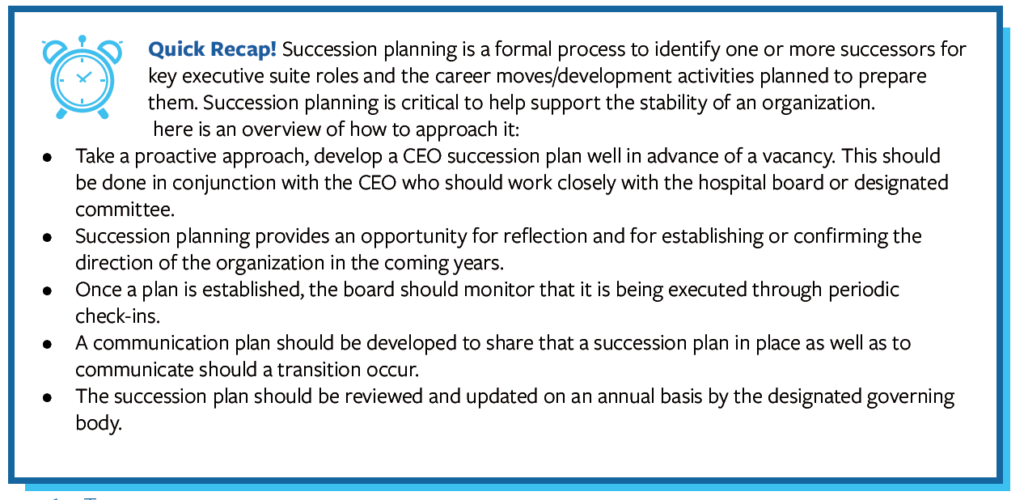The volatility in health care makes it critically important for organizations to have a strong and relevant succession plan in place to provide stability to the organization. According to the American Hospital Association’s 2022 National Health Care Governance Survey, nearly one-third of U.S. hospitals do not have or are unsure if they have a succession plan in place. Poor succession planning often results in poor performance, leading to more turnover and ultimately impacting an organization’s success.
What Is It?
Succession planning is a formal process to identify one or more successors for key executive suite roles and the career moves/development activities planned to prepare them. A succession or talent management program prepares future leaders and creates a legacy of leadership.
Developing potential leaders who can step into critical roles over time helps ensure smooth transitions when unexpected personnel issues arise. Succession planning for long-term vacancies is helpful for:
- Backup emergency planning should the CEO become incapacitated.
- Unexpected vacancy if the CEO leaves for another job.
- Anticipatory planning is when the CEO has indicated a planned retirement or departure date.
Succession planning improves filling key leadership positions since potential candidates have already been identified. Eventual successors can be developed within the organization based on an inventory of the hospital’s/system’s “talent pool.” Succession planning also helps create a vision of the skills needed by the organization in three, five and ten years. Succession planning also can assist the board in a short-term situation such as a 90-day leave of absence for a medical or personal reason. The process helps identify gaps in technical knowledge that will be needed, and mid-level leaders can be prepared for the future with ongoing education, training, and assignment of special projects, assuming the individual is interested.

How Does Succession Planning Work?
The succession planning process for the CEO position is board-driven, while the CEO takes the lead on developing up-and-coming managers for senior-level positions. The board and CEO should collaborate on these activities, and an outside consultant can help coordinate, facilitate, and evaluate the succession plan when it is finished. Periodic assessments of leaders and positions should be conducted, and the plan updated. Successful succession planning programs should:
- Determine the plan’s goals and focus on them.
- Be simple.
- Form a board committee charged with developing the plan.
- Develop a list of questions that need to be addressed.
- Address compensation matters.
- Ensure there is a champion of the process – usually the board chair.
Information is garnered from interviews with members of the governing board, the CEO, senior leaders, and other selected stakeholders about what will be needed to achieve strategic goals.
Areas of Potential Concern
Succession planning creates several areas of concern, including:
Communication – The secrecy level in succession planning is gradually reduced, but the hospital may need to decide to whom the plan is communicated and how it will be communicated. It may be appropriate that all employees understand that the hospital has a succession planning process and how it works. Those covered by the process should be able to provide input about their career goals, preferences, and limitations. These individuals should also receive feedback from the organization about how they are viewed, potential development needs, and possible job moves.
Feelings of entitlement – The board should strive to avoid creating an expectation of promotion to the CEO role by executive staff who may think they are “in line” for progression; this requires thoughtful, deliberate messaging.
Follow-through – After investing in a talent inventory and making a plan for developing future leadership, the board, CEO, and human resources director must follow through. Don’t draft the plan and put it on a shelf. The plan should be implemented, reviewed, and updated at least annually.
Medical staff involvement – This critical group of stakeholders must be part of the process, but physician participation may create concerns about confidentiality, strategic planning, etc. The board and CEO must determine the level of involvement of critical physicians and their knowledge of the plan.
Succession planning must be in sync with the organization’s business strategy. The succession plan should influence job filling and development.
Key Takeaways
Although the board governs the hospital, the CEO is the one who manages it on a day-to-day basis and is mainly responsible for its success or failure. Essential ideas to remember include the following:
- The board’s sole employee is the CEO, and board members should monitor performance and outcomes
- Having the right CEO at the helm is critical, the selection process and decision should be informed, fair, and transparent.
- The CEO’s senior leadership team helps implement the board’s vision and policies, so grooming up-and-coming managers is essential for long-term continuity and success.
- A good board/CEO relationship is critical for the overall performance and management of the hospital. Investing in building and maintaining a close, effective working relationship benefits the hospital, its patients, and the community.
